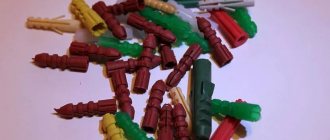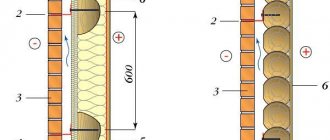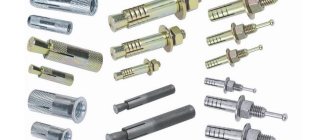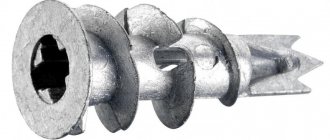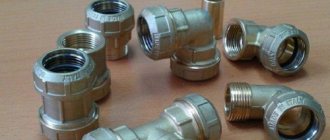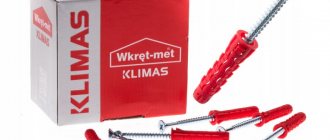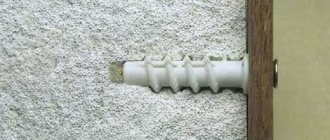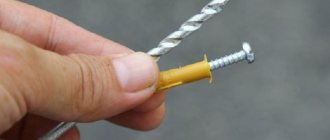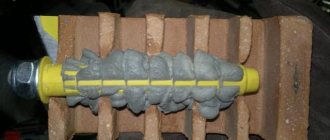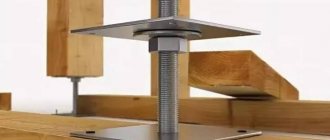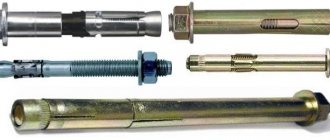Concrete is a very diverse material. A mortar can include a variety of components, have very different density and permeability characteristics, and be intended for a variety of needs. Accordingly, it is impossible to offer universal fasteners that would be suitable for all types of this material.
Dowel is the most suitable option for working with concrete.
What is a classic dowel?
The classic dowel for concrete and other solid materials has been preferred by specialists in the field of construction and repair for a long time. Consumers often call it a “dowel-nail.” Concrete fasteners can be made of metal, nylon and various types of plastic. Naturally, products made from different materials differ in their characteristics and, accordingly, in their area of application.
Polypropylene dowel-nail with a hidden side
The load-bearing capacity of a dowel on concrete is determined by its design features. In the classic design, a dowel-nail is a sleeve, the entire outer surface of which has special notches that prevent such an element from turning in a hole in a wall or in any other building structure. Special whiskers, which, due to their elasticity, are constantly in a decompressed state, help prevent the fastening element from being pulled out of the wall. When a screw is screwed in, the fastening element expands due to longitudinal slots on its surface, which ensures high reliability of its fixation.
Parameters of dowel-nails with a mushroom-shaped edge used for through installation (click to enlarge)
In addition to dowel fasteners, which operate on a mechanical principle, the modern market offers dowels for porous concrete and other similar materials, fixed in the holes through the use of a special adhesive composition. By filling the internal cavities of the porous material, the adhesive composition reliably fixes such an anchor element in a previously prepared hole.
The classic dowel-nail intended for concrete is such a universal fastener that it is quite difficult to list all the areas of its application. With its help, they install frames for various purposes, attach furniture and interior items to the surface of walls, fix household appliances at the required installation location, and also solve a whole list of other important tasks.
Metal driven dowel nails can be made of steel or aluminum alloys
This is interesting: How to easily remove an anchor bolt from a wall: basic techniques
Features of the selection and use of plastic dowels
A dowel is a fastener that is applicable for a wide variety of materials and is characterized by a fairly high load-bearing capacity - from 10 to 200 kg, and this does not mean the maximum, but the working load. A dowel, even a plastic one, provides a much stronger and more reliable fastening than a nail or screw; it is second only to anchor fastenings, and even then not always. How do they achieve such qualities, since plastic itself is not a material as strong as steel?
Of course, metal fasteners can withstand a higher load with all other parameters being the same. However, when fixing it in the material, it turns out that not everything is so simple.
The tear test of plastic dowels is presented in the video below:
Advantages and disadvantages
The metal has excellent hardness and strength. At the same time, its elasticity is noticeably lower, and there is no need to talk about viscosity or elasticity. If you intend to fix a heavy structure to a dense heavy material - concrete, solid brick, of course, a metal dowel will be the best solution. But if you need to fasten household appliances or furniture, or the wall material is loose, porous or worn, metal turns out to be an unsuitable option.
- Firstly, the steel sleeve, even when wedging, does not create super-dense contact with the material, but to some extent retains its shape. This is sufficient for penetration into dense material, but in porous material it will lead to pullout.
- Secondly, the steel creates tension at the point of contact. Dense material perceives it, but at least somewhat light material begins to collapse.
- Thirdly, steel products require mandatory protection, since they are not resistant to corrosion.
- Fourthly, metal products, with rare exceptions, are not suitable for installation on sheet material, such as drywall or sheet steel.
Plastic - polypropylene, polyamide, polyethylene - has a number of advantages that have made the plastic dowel so popular.
- The main advantage is the viscosity and elasticity of the polymer. Unlike metal, plastic is quite easily deformed, but does not lose its properties. When the screw is tightened, the plastic dowel not only expands, but compresses the walls of the hole, repeating its shape. It is this feature that ensures maximum contact density, that is, maximum friction force.
- It is much easier to give plastic a complex shape, while maintaining its elasticity and elasticity. When introducing, for example, a metal expansion dowel, the protrusions on the sleeve will partially cut and destroy the wall material. Plastic teeth and ridges apply pressure to the material and compress according to its structure.
- The ease of deformation of plastic also determines its use when mounting on porous materials. In this case, it is impossible to hold the fastener by friction, since high contact density cannot be ensured in aerated concrete. The plastic dowel is much easier and faster to deform in order to form a persistent knot and thus hold the attached material.
- Polymers do not need protection, as they are not prone to corrosion or mold. Their only significant drawback is flammability. Modern materials are self-extinguishing, but even in this case it is not recommended to use plastic dowels when fixing flammable structures - gas pipes, for example.
In any case, the cost of plastic is noticeably less. Even with a lower load-bearing capacity, it is more profitable to use it.
Expansion dowels with plastic rod brand IZO
Selection factors
The choice of products is carried out according to many parameters, since literally each type of fastening has its own dowel. Taken into account:
- wall material - concrete, foam concrete, solid or hollow brick, leaf material, etc.;
- material to be fixed – its weight, thickness, chemical inertness, composition;
- fastening method - preliminary or through installation;
- expected operating load;
- dimensional parameters - diameter and length of the product.
Material for making fasteners
A dowel for concrete can be made of metal or plastic. Metal guarantees strength and rigidity and has greater load-bearing capacity. Plastic fasteners are not subject to corrosion, have greater elasticity and viscosity, therefore they are easily deformed and even under such influences the fastener is not destroyed.
All plastic pins will burn even after the flame source is removed. Therefore, this type of fastener is not used in fire hazardous facilities.
Plastic dowels for concrete:
- Polyethylene - resistant to acids, lightweight, provide excellent viscosity, are not afraid of deformation, and act as a dielectric. Over time, the material may age and crack. Cold-resistant – fasteners can be used in temperatures down to -40 C.
- Polypropylene - less resistant to cold, but provides greater wear resistance and hardness. The material is resistant to heat - it deforms only at temperatures above +140 C. It can also crack.
- Polyamide (nylon) dowels for concrete are strong, rigid, viscous, resistant to vibration, are not afraid of mechanical damage, and have good wear resistance. Such dowels are considered the most reliable and durable, but have one drawback - they are hygroscopic, and therefore exclude the possibility of installation in frost and high humidity.
Metal dowels for concrete are not much different in structure and shape from plastic fasteners, but are presented in a smaller range. The metal is rigid and durable, but it has less viscosity and elasticity, so it loses its properties when deformed.
Metal dowel-nails for concrete:
- Galvanized and stainless steel are not afraid of corrosion and provide a reliable, rigid connection.
- Special alloys with chromium, titanium, bronze, brass are durable, particularly resistant to corrosion, and are expensive, so they are relevant only for certain cases, particularly important fasteners.
Typical sizes
Let us present the main characteristics of universal products in the form of a table:
| Type | Dimensions | Installation | Permissible load (brick, concrete) | ||||||
| d | L | t | d | h1 | Nbet. | Vbet. | Nbrick. | Vbrick. | |
| Expandet Nail Anchor | Ext. anchor diameter, mm | Anchor length, mm | Max. thickness of fixing item, mm | Diameter dia. holes, mm | Min. height depth holes, mm | Tensile load, kg | Cross-river load, kg | Tensile load, kg | Cross-river load, kg |
| 5×30 | 5 | 30 | 5 | 5 | 40 | 30,59 | 35,69 | 20,39 | 35,69 |
| 5×40 | 5 | 40 | 15 | 5 | 50 | 30,59 | 35,69 | 20,39 | 35,69 |
| 5×50 | 5 | 50 | 25 | 5 | 60 | 30,59 | 35,69 | 20,39 | 35,69 |
| 6×35 | 6 | 35 | 5 | 6 | 45 | 45,88 | 56,08 | 30,59 | 56,08 |
| 6×40 | 6 | 40 | 10 | 6 | 50 | 45,88 | 56,08 | 30,59 | 56,08 |
| 6×50 | 6 | 50 | 20 | 6 | 60 | 45,88 | 56,08 | 30,59 | 56,08 |
| 6×60 | 6 | 60 | 30 | 6 | 70 | 45,88 | 56,08 | 30,59 | 56,08 |
| 6×70 | 6 | 70 | 40 | 6 | 80 | 45,88 | 35,69 | 30,59 | 35,69 |
| 8×50 | 8 | 50 | 10 | 8 | 60 | 56,08 | 91,77 | 45,88 | 91,77 |
| 8×60 | 8 | 60 | 20 | 8 | 70 | 56,08 | 91,77 | 45,88 | 91,77 |
| 8×80 | 8 | 80 | 40 | 8 | 90 | 56,08 | 91,77 | 45,88 | 91,77 |
| 8×100 | 8 | 100 | 60 | 8 | 110 | 56,08 | 50,98 | 45,88 | 50,98 |
| 8×120 | 8 | 120 | 80 | 8 | 130 | 56,08 | 50,98 | 45,88 | 50,98 |
| 8×140 | 8 | 140 | 100 | 8 | 150 | 56,08 | 50,98 | 45,88 | 50,98 |
| 10×80 | 10 | 80 | 30 | 10 | 90 | 76,47 | 50,98 | 56,08 | 50,98 |
| 10×100 | 10 | 100 | 50 | 10 | 110 | 76,47 | 50,98 | 56,08 | 50,98 |
| 10×120 | 10 | 120 | 70 | 10 | 130 | 76,47 | 50,98 | 56,08 | 50,98 |
| 10×140 | 10 | 140 | 90 | 10 | 150 | 76,47 | 50,98 | 56,08 | 50,98 |
| 10×160 | 10 | 160 | 110 | 10 | 170 | 76,47 | 50,98 | 56,08 | 50,98 |
Table 1.
Here the lateral load is the weight that the dowel can support. This is a force directed vertically. That is, from the center of the edge of the fastener to the ground.
Sometimes it is useful to know how many kilograms there will be in 1000 pieces of fasteners. Especially if there is a lot of work to be done and the size of the warehouse is limited.
| Type | Weight 1000 pcs., kg |
| With polypropylene dowel | |
| 6×40 | 3,3 |
| 6×60 | 4,89 |
| 6×80 | 7,28 |
| 8×60 | 8,5 |
| 8×80 | 11,02 |
| 8×100 | 13,78 |
| 8×120 | 16,53 |
| 8×140 | 19,3 |
| 10×100 | 15,32 |
| Gun nails | |
| 4,5×30 | 5,1 |
| 4,5×40 | 6,45 |
| 4,5×60 | 7,7 |
| 4,5×60 | 8,84 |
table 2.
Overview of species
The development of expansion dowels has led to the emergence of several types. Let us highlight those that were developed for installation in a brick wall.
They can be classified according to several criteria:
- dimensions (length and diameter);
- application (construction, facade, universal);
- according to the type of brick for which they are used (solid or hollow);
- according to the method of fastening;
- according to the material.
As you can see, the variety of consumables can be quite large. Let's try to classify them by type, as this happens in a hardware store.
- The first group is united by the common name dowel-nail. This is a universal fastening element that can be successfully used for structures made of solid bricks; it is important not to get into the space between the bricks during drilling, in which case securing such a dowel will be problematic.
- Facade anchor is the fastener most suitable for hollow bricks, although you can try using it for solid bricks. Such dowels are made from both metal and plastic.
- The disc-shaped one is designed for installation of thermal insulation and has an elongated shape with a special device for fixing the insulation without deforming it, the spacer part being at the very end of the dowel.
Types of fastening
Plastic dowels are classified according to many characteristics. Sometimes it is easier and faster to select fasteners according to their intended purpose - for thermal insulation, roofing, frame, sometimes you need to know the design features in order to take into account all the features of the material.
In general, the design of the dowel is as follows.
- The non-expanding part is that part of the sleeve that does not change when the screw is tightened. Its purpose is to hold the dowel in the exact position during installation. It also prevents contact of the nail with the wall material. The non-expanding part passes through the attached material, where it plays the role of a regular nail, so its length is determined by the thickness of this material. With through installation, the length of the fragment is greater, since it includes the thickness of the heat-insulating layer, for example, or the air gap.
- The spacer part is the working part; when the screw is screwed in, it expands, twists, folds, that is, it is deformed in a certain way. The spacer part may include teeth, spikes, ailerons, protrusions, and must have slots, thanks to which the sleeve can change shape without ruptures or damage.
Depending on the number of slots, the fastener can have several thrust directions. Double-spacer, for example, is the simplest and cheapest, but creates uneven pressure. The four-spacer holds better and does not turn when screwing in the screw.
The design and proportions of the spacer and non-spacer parts are the basis of the classification.
According to the structure of the spacer part
Since the design of the dowel is determined by its purpose - a sort of ratio between the characteristics of the wall material and the characteristics of the attached material, this classification can be considered the most universal. Based on the type of dowel, it is easy to understand what purposes it is intended for.
- K – studded. The simplest and most common option. The sleeve is wedged almost along its entire length, the non-expanding part is small, the largest expansion is in the front part of the sleeve. There are spikes on the surface of the sleeve, which ensure tight contact with the wall material.
- S – universal fastener for concrete and solid brick. The sleeve is equipped with teeth that are denser and higher: when compressed, they significantly increase the friction force. In addition, there are locking tabs that prevent the dowel from turning during installation.
- U is a truly universal dowel, since it can be mounted on both solid and hollow bases. The sleeve has 3 petals, which, when in contact with concrete, for example, increase the friction force when wedging the dowel. In a hollow brick the picture is different: the sleeve is deformed when a screw is screwed in, literally screwing onto it, and forms a three-dimensional thrust unit.
Type U fasteners are used for fixing to any brick, concrete, plasterboard and any other panel bases.
- T – three-leaf dowel for brick and concrete. When the screw is screwed in, the sleeve expands along its entire length, the petals are pressed tightly against the walls of the hole. The fastener can be installed with a screwdriver, since it does not rotate in the hole.
- N – four-spread dowel, ensures uniform distribution of pressure on the walls of the hole. It is made only from nylon and has a high load-bearing capacity. It is used for fastening to solid and hollow bricks, as well as concrete.
- Butterfly - designed for fastening to sheet material: drywall, plasterboard, panels, that is, material with a thickness of no more than 10–12 mm. The dowel passes through the thin base and folds, pressing tightly against the back of the sheet. This design makes it possible, for example, to hang chandeliers from a plasterboard ceiling.
- Fasteners for foam concrete - longitudinal ribs on the sleeve change direction. When screwed in, the sleeve expands, and the ribs form almost one whole with the porous material.
- Spacer - a classic version of the dowel, where the spacer part can have a different number of petals, necessarily includes teeth and protrusions, and in the tail part, as a rule, there is a hole, which makes tightening the screw easier. In fact, most types of dowels are a modification of spacer ones.
- Dowel-nail - the spacer part of a plastic product is designed in the simplest way: as a rule, it is a double-spacer sleeve with small teeth. But during installation, the nail is simply driven into the sleeve, and not twisted. This method significantly speeds up installation, and therefore is used when it is necessary to fix a large number of structures and materials.
- Piranha - designed for installation in chipboard, wood, brickwork, thick panel bases. The sleeve has reverse-directed teeth: such fasteners have good tear resistance even in soft material, such as chipboard.
Plastic dowels with screws 8x60 mm
According to the structure of the non-expanding part
This fragment of the dowel is conditionally considered non-working. In fact, its design is also of considerable importance.
One of its main characteristics is length. On this basis they distinguish:
- conventional fasteners - that is, designed for the traditional installation method: pre-drilling a hole and immersing the dowel into it for the entire length. This option has restrictions on the thickness of the attached material, which is indicated in the manufacturer’s catalogue;
- elongated - in this case, the non-spacer part can be the same length or even longer than the length of the spacer. The model is designed for through installation. This category includes, for example, a facade dowel: the fastener must pass through the facing material, a layer of thermal insulation or a ventilation gap, and then end up in the wall material.
The frame dowel has the same structure: the plastic structure is not pressed tightly against the wall, this gap later foams. In addition, frame fasteners can be used in slotted materials: the non-spacer part ends up in a void, and the spacer part ends up in a dense area.
The structure of the upper part of the dowel is mainly important for the material being attached. There are such product groups.
- Dowel without a shoulder - used when installing in dense material, where the possibility of twisting or misdirection is minimal.
- Option with a collar - if there is such a danger, the collar will fix the dowel on the surface of the base and will not allow it to rotate when screwing in the screw. This same device prevents the fasteners from falling into the hollow material.
- Disc-shaped dowel - for thermal insulation. The fastener has a very wide head - from 40 to 90 mm in diameter and is designed to hold soft and loose material: basalt wool, mineral wool, as well as hydro- and vapor barriers.
Fastening material
Of all the possible plastics, 3 are used for the production of fasteners - polyethylene, polypropylene and polyamide. This is due both to the quality of the material and its availability.
Polyethylene
Polyethylene is a thermoplastic polymer, lightweight, colorless, chemically inert - resistant to most acids, bases, oil and gasoline. It is a dielectric, that is, it does not conduct electricity, it is resistant to cold - it does not change its properties down to -40 C. It is less resistant to heating: already at 80–120 C it softens and deforms.
Polyethylene is an excellent shock absorber, so it is very resistant to impacts and mechanical damage. For a dowel, this means ease of deformation and preservation of properties in a new form - elasticity, ductility and impact resistance.
The disadvantage is flammability. Even self-extinguishing plastic will burn in the presence of a fire source and will in any case deform as the temperature rises.
Polypropylene
Polypropylene is a thermoplastic propene polymer. It has a lower density compared to polyethylene, but is harder and abrasion resistant. In addition, polypropylene can withstand heating up to +140 C, and only then begins to melt. The material is not subject to cracking, but is sensitive to ultraviolet radiation. The latter can be solved through additives.
Polypropylene is chemically inert and is only affected by very strong acids and appropriate organic solvents. It is resistant to water, so polypropylene dowels can be used for external fastening and for installation in damp rooms.
Only stabilized polypropylene is used for the manufacture of fasteners: these components prevent aging of the material.
Polyamide
Polyamide - or nylon. This is a group of crystalline thermoplastics characterized by high strength, toughness and rigidity. Its important characteristic is vibration resistance, which allows the use of nylon products in literally any construction work.
Polyamide dowels are most often used in outdoor work, since the products are little sensitive to weather factors, and among aggressive substances, only very strong oxidizing agents such as ozone or sulfuric acid act on nylon. However, installation must be done in relatively dry and warm weather: polyamide, due to its crystalline structure, absorbs moisture and changes volume.
Manufacturers consider polyamide to be the best solution, despite the high cost of the polymer and its hygroscopicity.
Read below about which GOST regulates the dimensions and other characteristics of plastic dowels.
Plastic dowel 6x40
Dowel selection
When purchasing various objects to attach to a concrete wall, you should choose the right dowel for concrete; its approximate dimensions can be selected from the table:
Table for determining the dimensions of a fastener depending on the type of load on it
Fasteners are selected depending on the type of place where they will be used.
Before driving a dowel into a concrete wall, the future load must be taken into account:
- To secure structures of large mass, for example, wall bars or wall-mounted exercise machines, it is best to use dowels with a mounting depth of at least 85 mm;
- When fixing horizontally into a concrete wall, it is recommended to purchase fastening elements in which the fastening depth is at least 30 mm, and the diameter of the dowel on the outside is 7 - 11 mm;
- For the installation of a suspended ceiling, lamps, where the main load is located below, fasteners should be selected with spacer antennae and transverse notches;
- When selecting dowels for an already drilled hole, it is important that the parameters of the fastener and the diameter of the hole match each other. In this case, the dowel for expanded clay concrete or other material must have a diameter no less than the size of the hole;
- When using mounting fasteners, in order to prevent the destruction of weak walls, the dowel should serve as a softening pad. In this case, the fastener fits quite tightly to the fastener, and the load is distributed evenly throughout the product.
Features of installing dowels in the wall
Technology for installing dowels in a concrete wall
To do the work yourself you need to purchase:
- Electric drill;
- Pobedit drill;
- Sharp nail;
- Dowel of the desired design;
- Electrical tape;
- Small hammer.
After preparing all the tools, you can begin installing the dowels.
Work instructions:
- Mark the installation location of the fasteners with a ballpoint pen or a simple pencil;
- A small indentation is made with a nail, hacksaw or pin. This will allow you to correctly align the drill when making a hole;
Tip: The diameter of the fastener must match the size of the hole and screw. In this case, the dowels should fit into the holes with little effort. Otherwise, the fasteners will dangle or move to the side. It is imperative to choose the correct dowel length in accordance with the length of the self-tapping screw used.
- If the number of dowels was calculated incorrectly, you can make the product yourself. To do this, take wooden blocks of the required length. They are given a rounded cross-section, thickening at the top and decreasing in diameter at the bottom. After this, screw the screws into the concrete without a dowel;
- A drill of the required diameter is inserted into an electric drill;
Tip: Make a mark on the drill that will correspond to the depth of the hole. The mark is placed at a distance slightly greater than the length of the dowel. To do this, the fastening element is applied to the drill, and electrical tape is wound around it in the right place; it will mark the boundary of the drilling depth of the hole.
- The drill is placed in the previously made recess. The drill is positioned strictly perpendicular to the surface;
- The resulting dust and cement chips are removed from the drilled hole. This can be done using a vacuum cleaner;
- The dowel is carefully inserted and hammered in with a hammer, but not too hard, until it stops;
- A screw is screwed into the dowel if it is included in the structure.
Tip: In everyday life, you should use dowel-nails made of polypropylene or nylon. They can withstand loads of up to 75 kg, which depends on the size of the fastener. Steel products are used most often in industrial facilities.
To correctly hammer a dowel into a wall, you should watch the video in this article.
Installing a spring dowel
Installation of dowel-nails in brick and concrete foundations
In order to mount a dowel-nail into a brick, a hole of the appropriate depth and diameter is first drilled in it. To do this, proceed in the following sequence:
- begin to drill the brick using a drill set to impact approximately in its center, being careful and, if possible, at low speeds for the first 10-15 mm;
- free the resulting hole from dust and debris;
- Lightly tapping the cuff of the dowel with a hammer, drive it into the hole;
- The nail is carefully driven in with a hammer or screwed in with a screwdriver or screwdriver.
If the base is concrete, then they act a little differently:
- the hole is marked using a nail or a center punch and a hammer;
- using a percussion hammer, a hole in the concrete corresponding to the diameter is drilled, and the depth of the hole should be 5-10 mm greater than the length of the dowel;
- the hole is cleared of dust and construction debris;
- the dowel is carefully hammered into the hole;
- carefully drive the nail, and not completely, leaving a distance of 3-4 mm from its head to the cuff. This is necessary for suspension.
Removing fasteners
When renovating an apartment, high-quality wall finishing is necessary. To prepare a room for wallpapering or applying any other decorative coating, it is necessary to level the walls, first freeing them from old fasteners.
Often you need to remove unnecessary dowels through which screws are attached. To do this, there are several simple ways to remove a dowel from a concrete wall.
For dismantling you will need:
- Self-tapping screw;
- Sharp knife;
- Corkscrew;
- Awl;
- Hammer;
- Punch;
- Soldering iron;
- Nail puller;
- "Bulgarian".
Dismantling method:
- To remove a regular plastic dowel, you can use a self-tapping screw of a suitable size. In this case, the self-tapping screw is screwed two-thirds into the dowel for a reliable connection with the part being dismantled. The head of the screw is clamped with pliers and pulled out together with the dowel. Sometimes you can use a regular table corkscrew;
- The head of the self-tapping screw screwed into the dowel is pryed off with a nail puller. Using this lever, the dowel is removed with less effort. But the main condition is a tight fit of the working part of the screw in the hole;
- The homemade wooden dowel is removed from the socket in parts. To do this, the element is crushed into several pieces along the wood fibers with a chisel with a thin blade and a hammer. After destruction, the dowel is carefully pryed up with a nail, the tip of a sharp knife or an awl, and pulled out;
- If the dowel sits firmly enough in the wall, it is not always worth pulling it out. In this case, with a sharp knife you need to cut off the part of the dowel that protrudes above the surface of the wall, and cover the resulting depression with construction plaster and carefully level it;
- When removing a dowel in which a piece of screw is stuck, use a heated soldering iron. The tool melts the plastic base of the dowel, then the piece of fastener is pryed off with wire cutters or pliers and pulled out of the socket;
- A metal dowel-nail driven into concrete with a construction gun should first be treated with frequent, fairly strong hammer blows on the protruding part of the part from different sides. Most often, the dowel becomes loose, and then it is relatively easily pulled out with a nail puller;
- If you cannot immediately loosen the metal dowel, you need to make a recess in the wall next to it using a drill with a carbide tip or a metal punch. This circular funnel reduces the adhesion area of the product to the wall material, which will make dismantling much easier. If this does not help, the protruding part of the dowel needs to be cut off with a grinder and the recess should be leveled.
To determine which dowel is best for concrete, you need to get acquainted with their types, advantages and disadvantages. In addition, it is worth understanding the technology for installing the product, and carefully following the basic construction rules when performing work.
This is interesting: Stainless steel profile pipe: types, characteristics, GOST
What is a dowel
A dowel is a fastening, one of its parts is inserted into the base. It makes it possible to install on any hard surface. The models sold by modern manufacturers have a wide range of uses. Thanks to it, it will be possible to fix the material into heavy and porous concrete, natural stone, plaster, brick, and slag concrete.
In terminological terms, a dowel is a kind of sleeve or sleeve. It is not able to form a reliable fastening, but it will clearly fix the material in the wall. The dowel is screwed or driven in, and the product will change its shape and become wider. Thus, the material will be reliably strengthened.
Consists of 2 parts:
- Non-expandable - one of the parts, located at the top of the product and does not change shape during installation.
- Expansion - when the screw passes into the sleeve, this part changes its shape and expands. Due to the expansion of the bushing, the walls of the hole are compressed, and the friction force becomes greater. This part of the fastener forms the fastener.
Materials
Which material is preferable? It would seem that what could be more reliable than metal? The advantages of this material are obvious: strength, durability, ability to withstand heavy loads. However, metal spacer fasteners also have disadvantages. First of all, their high price and, oddly enough, lack of universal use. As a rule, such dowels are used for mounting any structures to brick walls. It is perfect for hanging various large equipment: gas boiler, water heater, heating system elements, sports equipment, grilles, awnings, etc. A special type of metal consumables are frame fasteners designed for fastening window and door frames to brick walls.
In general terms, the design of a metal dowel is quite simple; in fact, it is a tube with an internal thread, at the working end of which slots are made, and its thickness becomes larger.
During the installation process, the dowel is inserted into a prepared hole of the appropriate diameter, and then a pin with an external thread is screwed into it. The pin expands the dowel petals, and they are securely fixed in the hole.
It is much cheaper to make dowels from plastic. This has resulted in a huge variety of plastic expansion dowels. The simplest of them have the same principle as described above for their metal counterparts.
A screw or self-tapping screw is screwed into the plastic sleeve; a special nail with a threaded notch can also be driven in. The introduction of a metal rod leads to expansion of the petals of the structure, which reliably fix the dowel in the material. Plastic dowels for hollow bricks have a special design.
During installation, their petals are twisted into tight “knots”, this helps fix them in voids. Reinforced plastic dowels can easily compete in terms of fastening reliability with some models of metal dowels. The use of plastic consumables is very widespread. From mounting pictures and mirrors to securing heavy equipment.
How long will the mortgage last?
Quick response
An ordinary self-tapping screw screwed into a profile through drywall can withstand a maximum load of 123 kg, after which the fastening is destroyed. Recommended working load for one point is no more than 50 kg.
This method of fastening is called “mortgage”. If you have a single-layer sheathing, and you need to hang something heavier than 30 kg, then you will have to install a mortgage. This is a piece of regular profile on the inside where you will have fasteners.
If you haven’t watched the video from Stroyhak (part 2) with testing dowels, at the very end, for comparison, Andrey screwed a black self-tapping screw into the profile through the plasterboard and measured the load with a canter. The self-tapping screw vomited at the 123kg mark. The recommended load for a single-layer sheathing with a mortgage is 50 kg, the same as for a two-layer sheathing, but without mortgages.
Which one is better to use?
It can be difficult to determine which type of dowel fastener is best suited for certain jobs, primarily due to the enormous variety. When purchasing dowels, of course, it is always advisable to consult the store so that you do not have to go to the store again. Let's try to give general recommendations. For solid brick, almost the same dowels are suitable as those recommended for concrete. If the walls are made of such material, you can say that you are in luck. Most universal dowels will work just fine. You can securely secure even heavy and bulky objects, not to mention shelves and cabinets.
It's a completely different matter if the brick is hollow. For hollow bricks, most universal dowels are completely unsuitable. Driving a dowel-nail into such a wall is dangerous, as it can cause the formation of cracks not only on the surface, but also in the partitions inside the brick; in this case, it will be simply impossible to fix anything in the same place, and the hole in the wall will have to be repaired.
For slotted and hollow bricks, special plastic dowels that roll into a knot are required, or metal anchors with petals that rest against the partition from the inside. You should work with such consumables very carefully, since, unlike solid bricks, those with voids are usually more fragile. Facing bricks, which combine strength with some decorativeness, require special care. The appearance of chips and cracks in this case is simply unacceptable. It is also important to remember that such bricks usually have voids to reduce their weight, which greatly limits the use of some anchors and dowel-nails.
For facing porous bricks, it is preferable to use elongated plastic dowels, which during installation form complex units that can securely fix them in the voids of such structures. The fasteners for red and sand-lime bricks are somewhat different. Red is usually softer, and there is a danger of turning the dowel in the hole if the diameter of the drill is incorrectly selected or during the drilling process the master failed to maintain the perpendicularity and the hole turned out to be slightly larger.
Sand-lime brick is more tolerant of minor flaws during installation.
General purpose expansion dowels
This is one of the widest groups of dowels that are used when installing furniture elements, suspended ceilings and other structures to the wall. As the name implies, fixation is carried out by expanding in the material, which means the wall must be quite dense.
Previously, instead of such dowels, wooden choppers were used. They were inserted into the drilled holes and self-tapping screws were screwed in, due to which the assembly was pulled apart and fixed. But it takes a long time to plan a chop from wood each time, so we developed expanding structures with standard dimensions for the diameter of the drills.
Description and principle of operation
For fixation, dowels of this type have moving parts that protrude outward as the screw is screwed in. The dowel itself is made of polyethylene, nylon or polypropylene. These are soft materials that are easily exposed to metal screws from the inside.
The length of the dowels can be extended, shortened or standard. There can be two, three or even four spacer blades. Some designs include a countersunk head to hide subsequent fasteners.
Expansion dowel device.
The “antennae” on the “body” of the element prevents the dowel from turning in the wall when the screw is tightened (due to a drill of the same diameter, the hole is slightly broken and without the “antennae” the plastic insert would easily rotate). The edge at the end prevents the dowel from being pushed deep into the wall.
Elements for fastening are available in standard diameters of 5, 6, 8, 10, 12,14,16 mm.
There are rare sizes of 4, 7 and 20 mm.
Difference in design
All expansion dowels have a split part, which diverges as the hardware is wrapped. The non-spacer base ensures that the integrity of the plastic structure is maintained. There may be a lip at the end to limit the insertion depth, but there are versions without it.
Expansion dowel in the wall.
All dowels in the group are also equipped with a guide cone, which ensures easier entry into the hole. According to the elements of tangential and anchor fixation, they differ into several types.
Expansion dowel with spikes
Installers call this model “chapai”. The design has serrated edges on both sides that release the fasteners in the hole. Two large spikes prevent turning until the teeth are engaged. This design is especially convenient when screwing hardware into the ceiling, when they can fall out under their own weight.
Expansion dowel with spikes.
Expansion reinforced dowel
It is most often called the “hedgehog dowel” because it has small protrusions on four sides that resemble spines. There are no long “antennae” in the design. Unlike the previous one, it expands along its entire length and is great for concrete. Due to fixation in all directions, the fastener can withstand increased loads well.
Expansion reinforced dowel.
Three-spread dowel
The model is designated as T-dowel. The spacer part contains, instead of teeth, solid, even ribs that reliably fix the fastener in the hole. The non-expandable base is equipped with conical projections that prevent the dowel from sinking into the wall. It is often used on brick and concrete to fix shelves, lamps, and paintings.
Three-spread dowel.
Application
In general, the expansion group of dowels perfectly resists shear loads, so the fasteners are optimal for walls. The weights hung on it press down, and the spacer part reliably holds the weight of up to 20-30 kg at each point. Dowels of this type are also suitable for floor installation, for example, to secure the linoleum threshold in a concrete floor. The impact from the legs is across the location of the screw axis and it does not become loose.
But when applying longitudinal force, for example, for attaching objects to the ceiling, they are not the best, since they are less resistant to pulling out. On ceilings and consoles, it is permissible to fix only light interior parts or technical devices (installation of wiring under a suspended decorative ceiling, fastening a lamp, etc.). The fixative holds well in concrete, stone, and brick.
Hollow brick
What kind of material is this? In modern construction, two types of bricks are used - hollow and solid. The main function of the first materials is the construction of buildings, which should be as strong and durable as possible.
This brick is good in all respects. The material is light, strong, and easy to install. However, it has a significant drawback. It does not retain heat well in rooms. Although hollow brick is practically no different in strength from solid brick, it is more often used in finishing work. The internal void in such a building material can range from 30% to 50%, depending on the type and manufacturer. Low-melting grades of clay are used as raw materials for such blocks. It is from this that red brick is made. There is another option. This is a silicate hollow white type. Let's look at the features and properties of mounting blocks.
All about dowel-nails: size table and fastener weight
Table of contents:
Let's imagine a typical task: you need to fix a heavy shelf for books on the concrete wall of a room. Self-tapping screws cannot be used. It will fall out. In Soviet times, a wooden dowel or, in other words, a chopik was inserted into a drilled hole for sealing. Nowadays a dowel-nail is used as a fastener: dimensions start from 5x30 mm. Here 5 is the diameter of the hole in the sleeve, and 30 is the length of the nail itself.
How to secure?
To strengthen the dowel in a brick wall, it is not advisable to use a hammer drill in impact mode to drill a hole; it is better to work in drill mode. Drill carefully without jerking, trying to maintain a right angle. This will help avoid the formation of cracks and chips.
To learn which dowel to use for hollow bricks, see the following video.
Installation type
There are two ways to install the fastener:
Manual . You will need a hammer drill, screwdriver or hammer. You will have to drill a hole, insert a sleeve into it with your own hands, and then screw or drive in the rod.
Automatic . Installation is carried out using a gun. Use a special nail without a dowel with a strength of 53-56 HRC on the Rockwell scale.
The second option benefits from high installation speed. But the first is good because the standard rod can be pulled out without damaging the material or design.
Types of fasteners for hollow materials
But do not think that such materials are too fragile. You can even lay various types of communications through them.
A large number of different fasteners have been invented and created for this building material. For example, this is a dowel for hollow bricks. And this is just one of the types. There are many types of fasteners. Below we will look at the features of each of them.
Material and coating
Most often, the part is made of various types of plastic (polyamide, polypropylene, etc. In practice, there are also dowels made of metal (rare cases, but they do occur). The nail in the element in question is an alloy of metals, but besides everything else , coated with zinc.
It is worth noting that there is a 6x40 dowel-nail with a thread, and there is one without it, so when choosing the fasteners you need, you should pay attention to this nuance.
Source
Dowel nail
Thus, the classic version of the dowel-nail is the most universal solution. With its help, you can install various frames, attach pieces of furniture to the wall, fix household appliances and solve a wide range of important tasks.
However, experts do not really recommend using these fasteners with hollow types of building materials. In this case, other elements should be applied. Fasteners for brickwork differ from nails in their increased size and the presence of a double expansion mechanism. Such a fastening element can be made of metal or plastic. As for the reliability of the fasteners, it is ensured by spacer elements, which during the driving process will not fall into the void, but into the solid part. It is due to this that the necessary fixation is ensured. The spacers are released by screwing a threaded screw or pin into it. An example of such fasteners is the Mungo dowel for hollow bricks. The device has proven itself in the market as a reliable fastening element.
These fasteners are used for installation of hydro- and sound-insulating materials. But it is also a universal part that is widely used with all types of materials in almost any conditions.
Today, facade dowels for hollow bricks are made in two types - anchor and disc. The dish-shaped version is suitable for installing thermal insulation materials. Anchor ones are used to install brackets for a ventilated facade.
What is the difference between a dowel for concrete and a dowel for brick?
High reliability of fastening obtained using dowel-type products will be achieved only if they are correctly selected not only taking into account their size, but also the material of the structure in which they will be mounted.
Experts do not recommend using concrete dowels for installation in brick building structures. This recommendation is especially relevant when it comes to hollow bricks. In this case, special fasteners are used for installation, which differ from a conventional dowel-nail both in design and in the features of use.
The extended dowel for hollow bricks has certain design features
Masonry fasteners have extended dimensions and a double thrust mechanism. Like a dowel designed for concrete work, such a fastener can be plastic or metal. The reliability of fastening a brick dowel is ensured by the fact that at least one of its spacer elements does not fall into the cavity in the brickwork, but into its solid part; it is this that ensures the required fixation of the anchor in the wall or any other building structure. The expansion of the dowel spacer sleeve occurs when a threaded rod or screw is screwed into it, the diameter of which must be selected correctly.
Some types of universal dowels (click to enlarge). It is simply impossible to show the entire numerous assortment.
A dowel intended for concrete works on a completely different principle and can only be used for installation in solid solid materials. Such a dowel is driven under pressure (which is why it is often called a nail) into a previously prepared hole. If you try to fix concrete fasteners in a brick wall, the internal structure of which has many air cavities, you can simply destroy the mounting hole. Even if such a dowel is metal and has a considerable length, you still will not achieve reliable fixation in brick or any other porous, hollow and not very durable material.
Considering all of the above, you should take a very responsible approach to the selection of fastening elements for structures made of various materials, differing both in their hardness and the characteristics of their internal structure. The markings applied by manufacturers on the packaging of such products helps to understand what a particular fastener is intended for.
Chemical
Chemical dowel for hollow bricks is a product of modern technology. It uses special substances that need to be introduced into the mounting hole. The compound will gain strength as this composition hardens.
Chemical compounds work based on the forces of cohesion and adhesion. These fasteners are used for connecting and fixing various building materials, as well as structures and products made from different materials. As for the strength of the connection that can be obtained, it is highly reliable. It significantly exceeds the characteristics of any friction anchors, expansion dowels and other types of fasteners. The chemical dowel for hollow bricks creates connections where the pull-off force is 2.5 times higher than any traditional one.
How does a dowel work, what is a dowel used for?
What is the dowel for? — To securely secure connections in places where it is impossible to reach with a screwdriver, dowels and nails are used. Also, the product is widely used due to the speed of installation work. After all, mounting nails quickly penetrate the surface and do not require special markings. They are used for attaching material to any surface, be it brick, concrete, wood. Builders emphasize that dowel nails are convenient with the joint use of a mounting gun. This greatly increases the resistance and durability of the structure in relation to thermal insulation and sound insulation.
We hope we have helped you make sure that the dowel is a versatile product that can be used at almost all stages of construction work. Therefore, if you want to make a wholesale order for any type of these fasteners, go to the product catalog, find the required bushing and place an order.
How to choose a dowel?
Content
What makes a good master? Nothing is too small for him! He also pays great attention to the choice of dowels. And this is no coincidence: an incorrectly selected or low-quality dowel can completely ruin the result of long-term work. Which dowel should I buy? How to choose a drill for a dowel? Let's find out!
We take into account what we will attach
Some building materials and structures cannot be fastened with conventional dowels. They require special, highly specialized fasteners, otherwise all the work may go down the drain. Let's look at such examples.
Thermal insulation and waterproofing
The most common option is a mushroom dowel (plate-shaped). Its large head allows you to attach polystyrene, polystyrene and other similar materials as firmly as possible and at the same time accurately.
